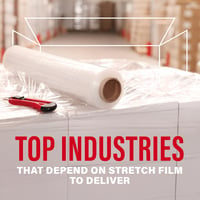Different industries have unique shipping and storage requirements, making the selection of...
The Ultimate Guide to Stretch Film

In the world of packaging and shipping, stretch film plays a crucial role in securing loads, protecting products, and ensuring shipments arrive safely. However, with various types, manufacturing processes, and specialty films available, choosing the right stretch film with your customers can be overwhelming.
This guide will break down the types of stretch film, industry applications, the differences between cast and blown film, and specialty films to help you make informed decisions when offering stretch film solutions.
What is Stretch Film?
Stretch film, also called stretch wrap, is a plastic film used to wrap around pallets, boxes, or individual products to keep them secure during storage or transport. It is highly stretchable, allowing it to tightly grip and hold items together while providing protection against dirt, moisture, and shifting.
Stretch film comes in two primary forms:
- Hand Stretch Film – Ideal for businesses wrapping pallets manually. This includes standard hand wrap for larger loads and bundling film for securing smaller packages, irregular items, or multiple boxes together without adhesives or tape.
- Machine Stretch Film – Used with automated stretch wrappers for high-volume applications, improving efficiency and consistency.
But not all stretch film is the same! The right choice depends on load type, shipping conditions, and industry needs.
Industries & Their Ideal Stretch Film Types
Different industries require specific types of stretch film based on their unique shipping and storage demands. Here’s how some of the country’s biggest industries use various types of stretch film.
1. Manufacturing & Industrial
Best Film Types: Blown Stretch Film, High-Performance Stretch Film
Heavy-duty machinery and metal components require high puncture resistance and strong load containment.
Blown stretch film is preferred for its superior durability and ability to handle irregularly shaped loads.
2. Warehousing & Distribution Centers
Best Film Types: Machine Stretch Film, Cast Stretch Film
These facilities handle high volumes of shipments, making machine-applied stretch film the best choice for speed and efficiency.
Cast stretch film is often used due to its cost-effectiveness and clarity, allowing for easy barcode scanning.
3. Food & Beverage
Best Film Types: Cast Stretch Film, Cold Storage Stretch Film, Vented Pallet Wrap
Cast stretch film is ideal for food packaging because of its high clarity, allowing for product visibility and easy labeling.
Cold storage environments require specialized stretch film that maintains flexibility in freezing temperatures. The die-cut holes in Vented Pallet Wrap create ventilation to allow airflow and help keep contents fresh.
4. Retail & E-Commerce
Best Film Types: Pre-Stretched Film, Bundling Film, Opaque Stretch Film
Pre-stretched film helps reduce worker fatigue while maintaining load security for smaller fulfillment centers.
Bundling Film is a simple way to secure smaller packages, irregular items, or multiple boxes together without adhesives or tape.
Opaque stretch film is often used to protect high-value shipments from theft by concealing contents.
5. Pharmaceuticals & Medical Supplies
Best Film Types: Anti-Static Stretch Film, High-Clarity Cast Film
Anti-static films prevent static buildup, which is essential for sensitive electronic medical devices.
High-clarity films allow for quick identification of medical shipments without unwrapping.

Cast vs. Blown Stretch Film: Key Differences
One of the most important factors in choosing the right stretch film is how it’s made. There are two main types: cast and blown stretch film.
Best for: Warehousing, e-commerce, food & beverage
- Manufactured using a casting process that results in a smoother, clearer film
- Offers excellent clarity, making it easier to scan barcodes and identify products
- Quiet unwinding, which is beneficial in noise-sensitive environments
- Lower cost due to more efficient production
Best for: Manufacturing, industrial, heavy-duty shipping
- Created using a blown extrusion process, making it more durable and tear-resistant
- Higher puncture resistance – ideal for irregular or sharp loads
- More load stability due to its superior cling and stretch retention
- Better performance in extreme conditions like cold storage or humid environments
Key Takeaway: If clarity and cost-efficiency are priorities, cast film is the best choice. If load containment and durability are more critical, go with blown film.
High-Performance Stretch Film: Maximize Efficiency & Strength
For customers looking to reduce material costs, improve load containment, and increase wrapping efficiency, high-performance stretch film is the ideal solution.
What Makes High-Performance Stretch Film Different?
Stronger with Less Film – Engineered for superior strength, meaning customers can use less film per load while maintaining or improving containment.
Higher Stretchability – Stretches further than standard films, reducing film consumption and lowering costs.
Lighter Weight, Greater Efficiency – Reduces worker fatigue for hand applications and increases throughput for machine applications.
Excellent Tear and Puncture Resistance – Great for irregularly shaped or heavy loads.
Ideal for High-Volume Operations – Often used in industries with large-scale shipping, such as manufacturing, warehousing, and distribution centers.
Industries That Benefit from High-Performance Stretch Film
Warehousing & Distribution – Reduces cost per pallet while improving stability for high-volume shipments.
Manufacturing & Industrial – Handles heavy and irregular loads without tearing.
Food & Beverage – Reduces film waste while keeping shipments secure.
Transportation & Logistics – Ensures products stay intact through long-haul transit.
Why It Matters for Your Customers:
Switching to high-performance stretch film can help reduce material costs by up to 50% without sacrificing quality. If your customers are looking for a way to cut costs, improve efficiency, and enhance load security, this is the film to recommend.
| Feature | High-Performance Stretch Film |
Standard Cast Stretch Film |
Standard Blown Stretch Film |
| Stretchability | Extremely high (up to 250-300%) – Uses less film per load | High (up to 200%) | Moderate (up to 150%) |
| Load Containment Strength | Superior containment with less film | Good containment but requires more layers | Excellent containment, especially for heavy loads |
| Puncture & Tear Resistance | Very strong, resists punctures even when stretched thin | Moderate resistance, more prone to tearing with sharp edges | Best puncture resistance – handles irregular loads well |
| Cost Efficiency | Uses less film per wrap, lowering cost per pallet | Lower cost per roll but requires more wraps | Higher material cost, but strong containment |
| Clarity & Barcode Scanning | Good clarity, balances performance & visibility | Highest clarity, great for scanning | Lower clarity, more hazy in appearance |
| Ease of Application | Lighter weight and easier to apply manually or by machine | Easy to apply, quieter unwind | Noisy unwind, requires more force to stretch |
| Best Use Cases | Warehousing & distribution, manufacturing, food & beverage, logistics | Retail, lightweight warehouse shipments, food & beverage | Heavy-duty loads, industrial applications, extreme shipping conditions |
Specialty Stretch Films
Beyond standard cast and blown stretch films, specialty stretch films cater to unique shipping and storage challenges.
- Already stretched during production, reducing the force needed for application
- Reduces film usage and worker fatigue, making it a cost-effective choice for manual wrapping operations
- Used to hide sensitive shipments and deter theft
- Helps with color coding for warehouse organization
- Protects pallets stored outdoors from sun damage
- Essential for industries storing products in direct sunlight for extended periods
- Features small holes to allow for airflow, preventing moisture buildup
- Used for products like fresh produce, plants, and beverages that require ventilation
- Prevents static buildup, protecting electronic components and sensitive equipment
- Lightweight & Easy to Use – No need for dispensers or extra tools
- Great for Shipping, Retail, and E-Commerce – Secures boxes, tubing, wires, and loose items
- Leaves No Residue – A cleaner alternative to strapping or adhesives
Choosing the Right Stretch Film with Your Customers
When selecting stretch film, consider:
- Load type – Heavy, irregular, or light?
- Industry – Food, pharma, retail, or industrial?
- Application method – Hand wrap or machine wrap?
- Environmental conditions – Cold storage, outdoor exposure, or static-sensitive environments?
By understanding the different types of stretch film, industry applications, and specialty options, you can help your customers select the best solutions for their business.
Looking to expand your stretch film offering or need guidance on the best products for your customers? We’re here to help!
Reach out to your account representative or contact BOX Partners Customer Support Team at 800-806-2636.
Explore our full line of stretch film today!








